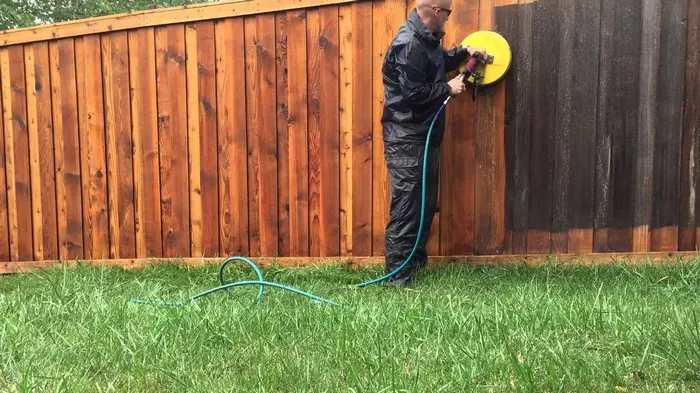White wood fences add a touch of elegance and charm to any property, but over time, they can become tarnished by dirt, grime, mold, and mildew. Fortunately, pressure washing offers a highly effective solution for restoring the pristine appearance of your fence. In this comprehensive guide, we’ll walk you through the process of cleaning your white wood fence with a pressure washer, ensuring optimal results while maintaining safety and preserving the integrity of the wood.
Safety Precautions
Before diving into the cleaning process, it’s crucial to prioritize safety. Pressure washers are powerful tools that can cause injury or damage if not used properly. Always wear appropriate safety gear, including goggles to protect your eyes, gloves to shield your hands, and closed-toe shoes for foot protection. Additionally, never point the pressure washer nozzle at people, animals, or delicate surfaces to avoid accidents or harm.
Preparation
Proper preparation sets the stage for a successful cleaning operation. Begin by removing any obstacles near the fence, such as furniture or garden decor, to ensure unobstructed access. Cover nearby plants or delicate surfaces with tarps or plastic sheeting to shield them from potential damage caused by the force of the water. Lastly, clear the area of debris, such as fallen leaves or branches, to prevent them from interfering with the cleaning process.
Choosing the Right Pressure Washer
Selecting the appropriate pressure washer is essential for achieving optimal results without causing damage to the wood. Consider factors such as pressure settings and nozzle types when choosing a model suitable for cleaning a wood fence. Opt for a pressure washer with adjustable pressure settings to ensure versatility and control. Additionally, choose a nozzle that delivers a wide spray pattern to cover larger areas efficiently while minimizing the risk of damage to the wood.
Detergent Selection
To enhance the cleaning process, use a mild detergent specifically formulated for pressure washers. These detergents are designed to loosen dirt and grime without harming the wood or the pressure washer equipment. Avoid using harsh chemicals or bleach-based cleaners, as they can damage the wood and surrounding vegetation. Instead, opt for eco-friendly detergents that are safe for both the environment and your fence.
Testing Pressure Settings
Before tackling the entire fence, it’s prudent to test the pressure washer on a small, inconspicuous area to determine the optimal pressure setting. Start with the lowest pressure setting and gradually increase it until you achieve the desired cleaning power without causing damage to the wood. Keep in mind that different wood species may respond differently to pressure washing, so adjust the pressure accordingly to avoid potential damage.
Technique
Mastering the proper technique is key to achieving professional-grade results when pressure washing your white wood fence. Begin by working from top to bottom in small sections, ensuring thorough coverage and consistent pressure throughout. Hold the nozzle at a consistent distance from the surface, typically around 12 to 18 inches, to prevent damage while effectively removing dirt and grime. Use smooth, overlapping strokes to ensure uniform cleaning and avoid streaking or uneven results.
Rinsing
Once the cleaning process is complete, thoroughly rinse the fence with clean water to remove any remaining detergent residue and debris. Pay special attention to crevices and corners where dirt and detergent may accumulate, using a sweeping motion to ensure thorough coverage. Proper rinsing not only removes residue but also helps prevent streaking or discoloration, leaving your fence looking fresh and clean.
Drying and Maintenance
After rinsing, allow the fence to dry completely before applying any sealant or paint. Proper drying ensures optimal adhesion and longevity of the finish while preventing moisture-related issues such as mold or mildew growth. Once dry, consider applying a protective sealant or paint to enhance durability and resistance to the elements. Additionally, incorporate regular cleaning into your maintenance routine to prevent dirt buildup and prolong the life of your white wood fence.
Troubleshooting and Additional Tips
Inevitably, you may encounter stubborn stains or other challenges during the cleaning process. For stubborn stains, consider using a specialized cleaner or applying gentle agitation with a soft-bristle brush before rinsing. To prevent streaking, maintain a consistent distance and angle when spraying, and avoid lingering in one area for too long. For optimal results, use a wider nozzle for large areas and a narrower nozzle for detail work, adjusting the pressure as needed to achieve the desired outcome.
Conclusion
In conclusion, pressure washing offers a highly effective solution for cleaning and restoring the beauty of your white wood fence. By following the guidelines outlined in this article, you can achieve professional-grade results while maintaining safety and preserving the integrity of the wood. Prioritize safety, proper preparation, and technique to ensure optimal outcomes and long-lasting beauty for your fence. With regular maintenance and care, your white wood fence will continue to enhance the aesthetics of your property for years to come.

